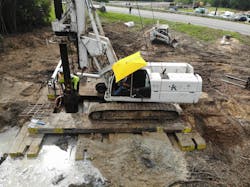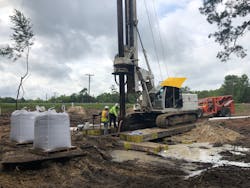Dewatering the Sabine River Pipeline Tunnel Sites
Bucket-auger method successfully manages tough conditions
The Sabine River Authority’s $75 million pipeline project, launched in early 2016, began with the task of dewatering tunnels under an open highway, an active railroad, and a set of gas pipelines.
Providing a border between Louisiana and Texas in far Southeast Texas, the Sabine River flows roughly 100 miles from US 190 to the Gulf of Mexico. The area is desolate with only two highways crossing the river: Highway 12 and US 190. Flowing through Newton and Orange Counties, the river provides water for local industry and municipal customers in the two counties. The infrastructure and location of the existing pump station, constructed in 1934, as well as changes within the river, have occasionally limited Sabine River Authority’s (SRA’s) ability to withdraw water from the river.
Crews from Houston-based TerraFirma Earth Technologies prepared the way for the 7-mile pipeline project by dewatering the bore and jack pits at three locations utilizing closely spaced deepwell dewatering wells. The 66” diameter pipeline had to be tunneled underneath the active Kansas City Southern railroad (143 feet in length), a set of active gas pipelines (110 feet), and Highway 12 (161 feet). Due to a period of very heavy rains just before construction began as well as during construction, the river rose ten feet, causing a subsequent rise in the water table and making the already difficult access to the various low-lying, swampy sites even more challenging to reach. Creative solutions were in order.
As Construction Manager at Risk (CMAR), Garney Construction encountered some hurdles that required special equipment and changes to the original dewatering plan. Crews were charged with dewatering three tunnel crossings — one beneath Highway 12, one beneath an existing set of gas lines, and another beneath the active Kansas City Southern railroad. The Authority didn’t want to disrupt traffic, so the team had to dewater 160 linear feet from entry shaft to exit shaft beneath Highway 12 while it was in use.
“Access to the river in such a rural location with no drainage structure in place, with the rapid fluctuation of the river, presented unique circumstances,” Chad Sharbono, project manager for Garney, said of another complication that interrupted the progress of the dewatering. “There were tight conditions TerraFirma had to get through to have access to the railroad and other tunnels. They were dewatering only about 100 feet from the rising river. Flows were changing constantly.”
According to Sharbono, the CMAR delivery model enabled the team to collaborate and reach agreement as adjustments needed to be made. “We were able to see unusual risks and budget for those, avoiding possible contention. In the end, both parties were able to manage a solution.”
As of February 2020, the tunnels have been successfully installed and the dewatering wells remain in place until the water conveyance pipeline tie-ins can be made. WW
About the Author
David Giles
David Giles, president of TerraFirma Earth Technologies, has 33 years of experience in groundwater control, with 20 years as a geologist for both the construction and remediation sectors. He enjoys collaborating with project teams to find the approach that will yield the highest value.


